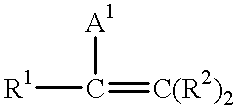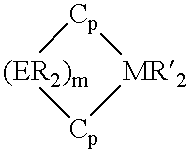Process for preparing thermoplastic vulcanizates
a technology of thermoplastic vulcanizate and thermoplastic vulcanizate, which is applied in the field of thermoplastic vulcanizate preparation, can solve the problems of low green strength, low ethylene content, and disadvantages of epm and epdm elastomers
- Summary
- Abstract
- Description
- Claims
- Application Information
AI Technical Summary
Problems solved by technology
Method used
Image
Examples
example 2
A sample, 24.0 g, of ESI42 ethylene / styrene interpolymer was added to the mixer and bowl used in Example 1. The bowl temperature was 140.degree. C. and the sample was mixed at 60 RPM. A sample of 0.48 g (1.54 mmole) of 4,4'-disulfonylazidophenyl ether was added and the resulting combined sample was mixed for 5 minutes, and then the resulting admixture was removed from the mixing bowl. The bowl was cleaned and the temperature was raised to 190.degree. C. A sample of 16.0 g of polypropylene commercially available from Montell Polyolefins under the trade designation Profax 6523-Lot BE31563 was added and mixed at 60 RPM. After 3 minutes, the pre-compounded ESI / 4,4'-disulfonylazidophenyl ether admixture was added to the melted polypropylene. After 7 more minutes (t=10 minutes), mixing was stopped and the ESI / PP TPV was removed from the mixing bowl. The sample was compression molded using the procedure of Example 1 at a temperature 190.degree. C. into a 1 / 16 inch (0.0016 m) thick plaque a...
example 3
Addition of Oil to a TPV of the Invention.
The process of Example 1 is repeated using 18.0 g of ESI42 ethylene / styrene interpolymer (ESI) 0.36 g (1.15 mmole) of 4,4'-disulfonylazidophenyl ether, and 10.0 g of polypropylene (PP) (commercially available from The Dow Chemical Company under the trade designation H 701-20NA-20 MFR) except that at t=9 minutes, 12.0 g of mineral oil commercially available from Shell Chemical Company under the trade designation Shellflex 371 was added dropwise to the mixing bowl via pipet over a period of 4 minutes. The sample was removed from the mixing bowl at t=15 minutes. This sample was compression molded into a 1 / 16 inch (0.0016 m) thick plaque and the tensile properties, upper service temperature, and hardness of the sample were measured. This sample was transparent in nature, suggesting very small domain size for the ESI phase and it was also much softer than the polymer composition resulting from Example 1 or 2.
This sample illustrates addition of oi...
example 4
Use of a Higher Styrene Content Elastomer in the Practice of the Invention.
The procedure of Example 1 is repeated except that the elastomeric phase is 26.0 g of ESI72 ethylene / styrene interpolymer (described previously) was used in place of the ESI42. This sample was compression molded into a 1 / 16 inch (0.0016 m) plaque and the tensile properties and TMA behavior of the sample was recorded (see Table 3). This sample illustrates the ability to produce TPV's with high styrene content ESI.
PUM
| Property | Measurement | Unit |
|---|---|---|
| Percent by mass | aaaaa | aaaaa |
| Percent by mass | aaaaa | aaaaa |
| Percent by mass | aaaaa | aaaaa |
Abstract
Description
Claims
Application Information
 Login to View More
Login to View More - R&D
- Intellectual Property
- Life Sciences
- Materials
- Tech Scout
- Unparalleled Data Quality
- Higher Quality Content
- 60% Fewer Hallucinations
Browse by: Latest US Patents, China's latest patents, Technical Efficacy Thesaurus, Application Domain, Technology Topic, Popular Technical Reports.
© 2025 PatSnap. All rights reserved.Legal|Privacy policy|Modern Slavery Act Transparency Statement|Sitemap|About US| Contact US: help@patsnap.com



